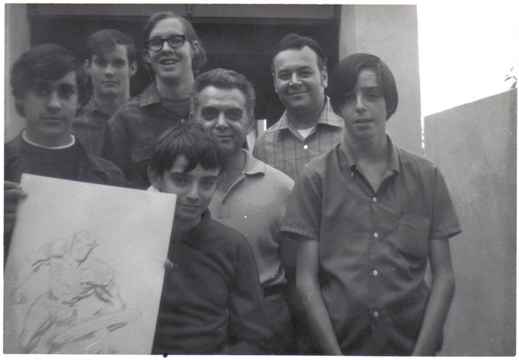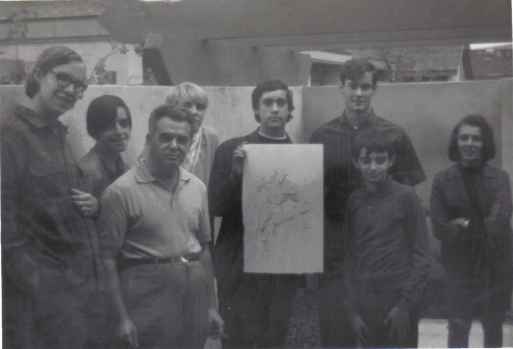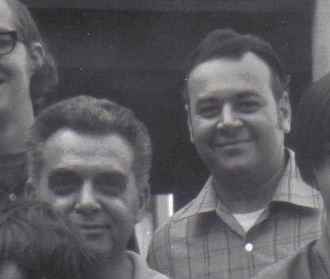
From left to right: Dan Stewart, Bob Sourk, Richard Alf (the tall guy with glasses), Barry Alfonso (in front), Jack "King" Kirby, Shel Dorf, and Wayne Kincaid. Picture taken on November 9, 1969 at the Kirby-family home in Irvine, California.

From left to right: Richard Alf, Wayne Kincaid, Jack "King" Kirby, Mike Towry (in back), Dan Stewart, Bob Sourk, Barry Alfonso (in front), and Sylvia Alfonso. Picture taken on November 9, 1969 at the Kirby-family home in Irvine, California.
On Sunday, November 9, 1969, Shel Dorf led a group of San Diego comic fans on their first pilgrimage to the home of Jack Kirby, who had recently moved from New York to Irvine in Orange County, California. Travelling with Shel were the rest of the first Comic-Con committee – Richard Alf, Barry Alfonso, Dan Stewart, Bob Sourk, and Mike Towry – a young friend of Barry’s named Wayne Kincaid, and Barry’s mother, Sylvia Alfonso. We all piled into a rented station wagon and Shel drove us to our rendezvous with destiny.
It might be hard for others to imagine just how much this trip meant to us and to the future of Comic-Con. It was a magical event in our lives, one that really bonded us as a group with a purpose and encouraged us to believe that we could fulfill that purpose. The purpose, of course, was to create San Diego’s first Comic-Con.
Here, now, are Barry Alfonso’s reminiscences of that trip he took forty years ago as a twelve-year-old comic fan from a sleepy little Navy town in the southwest-corner of the continental United States.
November 9, 1969: Memories
The beginnings of the San Diego Comic-Convention and our group’s first visit with Jack Kirby are inextricably linked in my mind. While it’s likely we still would’ve gone on to launch the Comic-Con, the Kirby visit made it a certainty. It certainly raised the seriousness of the whole project in my mind. If Jack Kirby would allow us to come to his home and learn the secrets of his art, then anything was possible!
Shel Dorf was the man who made it all happen. Looking back 40 years, I’m still amazed that we had met someone who was able to arrange such a meeting – and felt it was worthwhile to include a 12 year-old kid like me in the event. I’m not sure I appreciated just how lucky I was, although I did feel pretty impressed about the whole thing. My preconceptions about meeting celebrities were not yet formed at this time. While I had never met anyone in the professional arts before – certainly no one I admired half as much as Jack Kirby – I had no reason to think it couldn’t be done.
There are certain distinct things I recall about that first visit. I remember driving up with Shel, Richard Alf, Mike Towry, Bob Sourk, Dan Stewart and a friend of mine named Wayne Kincaid (who didn’t became part of the ongoing Comic-Con fan group). Also along was my mother, to make sure things were on the up and up. She needn’t have worried.
Jack and Roz Kirby had recently moved from New York to Irvine, CA. They were living in the sort of townhouse/apartment community found all over Southern California in the ‘60s: sandy-colored stucco buildings, no more than two stories, with that sort of “modern” interior design typical of the era. (This was before Jack bought his house in Thousand Oaks, CA.) When we arrived, Jack welcomed us inside. If I’m not mistaken, Roz had already prepared hamburgers for all of us. I’m sure I sat there eating my burger, taking it all in, maybe making a comment or two.
I don’t recall feeling intimidated at being in the presence of the King of Comics – Jack was completely welcoming and open, the way he always seemed to be. He was happy to answer any and all questions, professional or personal – and he had lots of specific advice about our projected Comic Convention.
This visit set the pattern for future visits: we would come to Jack’s house and he would answer our questions, which would range from specific queries about his work to broader matters of the comic industry and the world at large. Jack seemed to enjoy playing the role of the benign philosopher. I do think he got something from our visits, including that first one: an affirmation of his work and its impact, maybe even an idea or two for a character or story. I do know that I didn’t have the sense we were imposing on him – he seemed to enjoy our company.
The artwork I saw on that first visit is still vivid in my mind. I recall seeing one of Jack’s collages (combining his comic art with clipped photos) mounted on an easel or table in his living room – it was bigger and more intricate than anything that had appeared in print, probably depicting large machinery and rocks. This may have been the trip when he showed us his color illustrations of the Napoleonic Wars – a particular scene of Napoleon charging into battle stands out in my memory. Most of all, I recall a gallery of newly-created characters on display in one of the rooms of the townhouse. Among them was a god-like hero (or villain) called the Black Sphinx. I was so taken with this being that I made a crude sketch with pencil and paper. (I don’t think Jack would’ve felt threatened by this if he had known.)
Towards the end of our visit, we were gathered in Jack’s studio, firing off more questions. Around this time, I think it had been announced that he was putting aside work on either the Inhumans or Ka-Zar – I asked him if he had any unused plot lines from one or both of these comics. (No, he hadn’t.) Then I had the temerity to tell Jack that I didn’t like the way he drew Iron Man (his creation), because he let Tony Stark’s eyes show through his helmet! What gall! This was an indication of how comfortable we all felt around Jack. He took no offense at my statement –I imagine he thought it was cute.
Shel was asking questions as well. He was one of us – the fact that he was older and had been meeting comics professionals for 20 years didn’t entitle him to more status. Yet, of course, we all knew he was the reason we were there. Shel was more interested in bringing us together with our hero Jack Kirby than setting himself up as some sort of all-knowing insider. There was no sense of his angling for some sort of advantage in all of this. His intentions were genuine and done for the love of creativity – which is why Kirby was willing to entertain a troupe of strangers for an afternoon.
What a wonderful day – and, for me, a life-changing one. Thanks, Jack. Thanks, Shel.
— Barry Alfonso
Fortunately, Shel Dorf tape recorded our discussion with Kirby that day. A transcript of the tape appeared in issue #42 of the wonderful magazine Jack Kirby Collector from TwoMorrows Publishing with Shel’s permission. The transcription was by Steven Tice. The following are some extracts where our newly-forming Comic-Con was being discussed. Most interesting is that it was still an issue as to whether we should feature science fiction and films along with comics – as had the Detroit Triple Fan Fair conventions that Shel had worked on – or have a comics-only convention. As you’ll see, Jack Kirby weighed in on the side of the all-inclusive convention, which was the model we ultimately followed and the one still in use today.
One other note: it wasn’t always clear to the transcriber which of us was speaking so he just used the catch-all “FAN.” However, we’re pretty sure that none of us kids would have had the temerity to address the King of Comics by his first name, at least not at our first meeting, so where the “FAN” is addressing him as “Jack,” it’s most likely Shel speaking.
From Page 13 of Jack Kirby Collector #42:
JACK: You boys need to have something in mind; maybe we can discuss it and I possibly may have a suggestion or two that you could use when you do have your convention.
FAN: We were planning on having it right after school let out.
JACK: Have you had a convention before?
FAN: Not in San Diego, no. I didn’t even run one yet. Shel is the only one with the experience.
JACK: Well, Shel had been to the other conventions.
FAN: Yeah.
JACK: And you’ve seen some of the exhibits that they’ve had there.
FAN: Right.
JACK: I’d duplicate those exhibits, and I suppose you know some dealers who will have old pulps and comic books and other paraphernalia that go back to that period that might interest the boys. I guess the Big Little Books. I would suggest that you could contact some of the artists, like Joe Simon or Will Eisner. And maybe Bill Everett might have some old artwork around which I think might be of value to you.
From Page 15-16 of Jack Kirby Collector #42:
FAN: Well, in any case, Jack, we’re at the point now where we’re trying to decide whether this should be just strictly a comic convention, or if we should include the fans of science-fiction, the fans of films, and so on. What would your idea about this be?
JACK: I’d say do it all! Do comics and do anything that’s been relevant to it. I know that comic fans have also been interested in the movie media, they’ve been interested in the pulp media, and all that has some value to them. I think they want to see it. I don’t think they want to concentrate on comics alone. If you can widen the scope of the convention to include all these, I think you’ll have a larger crowd and a more interesting crowd. And I think you’ll have a great time.
FAN: Do you think we could get some publicity on our convention in the Marvel comics?
JACK: That’ll have to be up to Stan. I would write Stan. I would write Stan and tell him exactly what you plan. I’m sure he’ll go along with it.
And here’s just one more bit from the conclusion of our discussion. After reading Jack’s concluding words, we’re sure you’ll understand why we finished that day on cloud nine:
Page 18 of Jack Kirby Collector #42:
SHEL: Jack, I want to thank you for a very enjoyable afternoon, for taking the time to be with the San Diego fans. What do you say we split now and sit down and relax and have a cold drink?
JACK: Well, it’s fine with me. It’s been my pleasure to entertain all of you, if I’ve done that. And certainly I’ve learned a lot from you, and I’ve found it a very pleasant afternoon. And if we can do it again, why, it would be my pleasure. Because I consider you all my friends, and my friends are always welcome here.
 Jack Kirby (left) and Shel Dorf — Nov. 9, 1969
Jack Kirby (left) and Shel Dorf — Nov. 9, 1969